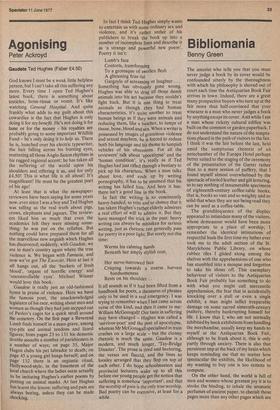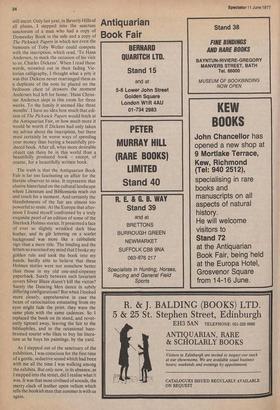Bibliomania
Benny Green
The amorist who tells you that you must never judge a book by its cover would be confounded utterly by the thoroughness with which his philosophy is shoved out of court each time the Antiquarian Book Fair arrives in town. Indeed, there are a great many prospective buyers who turn up at the fair more than half-convinced that your wiseacre is a man who never judges a book by anything except its cover. And while I am a man whose rickety cultural edifice was built on the common or garden paperback, I do not understand the nature of the temptations placed in the path of visitors to the fair. I think it was the fair before the last, held amid the sumptuous rhetoric of an antechamber of the Europa Hotel perhaps better suited to the staging of the ceremony of the presentation of the Garter rather than to a mere session of puffery, that I found myself almost overwhelmed by the spectacle of tooled leather and gilt lettering, so to say nothing of innumerable specimens of eighteenth-century coffee-table books, that is, books so vast and so weighty and so solid that when they are not being read they can be used as a coffee-table.
The grandiloquence of the display appeared to intimidate many of the visitors, whose demeanour would have been more appropriate to a place of worship; I remember the identical intimations of respectful hush the first time my father ever took me to the adult section of the St. Marylebone Public Library, on whose rubber tiles I glided along among the shelves with the apprehensions of one who has stumbled into a mosque and forgotten to take his shoes off. This exemplary behaviour of visitors to the Antiquarian Book Fair probably has something to do with what you might call mercantile apprehension, the fear that in accidentally knocking over a stall or even a single exhibit, a man might inflict irreparable damage on some sacred sixteenth-century psaltery, thereby bankrupting himself for life. I know that I, who am not normally inhibited by book exhibitions from handling the merchandise, usually keep my hands to myself at the Antiquarian Book Fair, although to be frank about it, this is only partly through anxiety. There is also that persistent imp at the back of my brain which keeps reminding rue that no matter how spectacular the exhibits, the likelihood of my wanting to buy one is too remote to compute.
On the other hand, the world is full of men and women whose greatest joy it is to stroke the binding, to inhale the aromatic perfumes of ancient paper, to cherish those pages more than any other pages which are
still uncut. Only last year, in Beverly Hills of all places, I stepped into the sanctum sanctorum of a man who had a copy of Domesday Book in the safe and a copy of The Pickwick Papers in which not even the humours of Toby Weller could compete with the inscription, which read, 'To Hans Andersen, to mark the occasion of his visit to us, Charles Dickens'. When I read those words, scrawled out in their fading Victorian calligraphy, I thought what a pity it was that Dickens never rearranged them as a duplicate of the note he placed on the bedroom chest of drawers the moment Andersen had left for home: 'Hans Christian Andersen slept in this room for three weeks. To the family it seemed like three months'. I have no idea how much that edition of The Pickwick Papers would fetch at the Antiquarian Fair, or how much more it would be worth if Dickens had only taken my advice about the inscription, but there must certainly be worse ways of spending your money than buying a beautifully produced book. After all, what more desirable object can there be in this world than a beautifully produced book — except, of course, for a beautifully written book.
The truth is that the Antiquarian Book Fair is far too fascinating an affair for the literate observer to miss. It represents that elusive hinterland on the cultural landscape where Literature and Bibliomania reach out and touch for a moment. And certainly the blandishments of the fair are almost too powerful to resist. At the Europa that afternoon I found myself confronted by a truly exquisite pearl of an edition of some of the Sherlock Holmes stories. It presented a face of ever so slightly wrinkled dark blue feather, and its gilt lettering on a scarlet background was more like a cabbalistic sign than a mere title. The binding and the letters so exercised my mind that I broke my golden rule and took the book into my hands, hardly able to believe that these Holmes stories were not somehow better than those in my old one-and-sixpenny paperback. Surely between such luxuriant covers Silver Blaze doesn't kill the victim? Surely the Dancing Men dance in subtly differing configurations? But when I looked more closely, apprehensive in case the beam of ratiocination emanating from my eyes might fade the print, they were the same plots with the same cadences. So I replaced the book on its stand, and reverently tiptoed away, leaving the fair to the bibliophiles, and to the occasional harebrained tourist who likes to buy his literature as he buys his paintings, by the yard.
As I stepped out of the sanctuary of the exhibition, I was conscious for the first time of a gentle, seductive sound which had been with me all the time I was walking among the exhibits. But only now, in its absence, as I stepped into the street, did I realise what it was. It was that most civilised of sounds, the merry clack of leather upon vellum which tells the bookish man that summer is with us again.



































 Previous page
Previous page